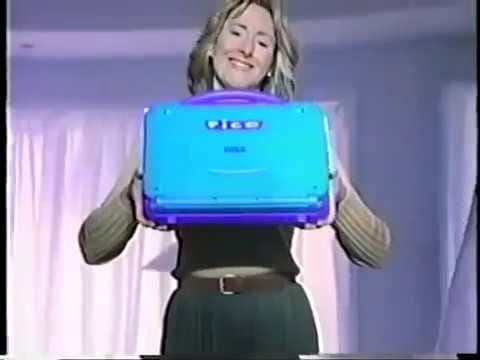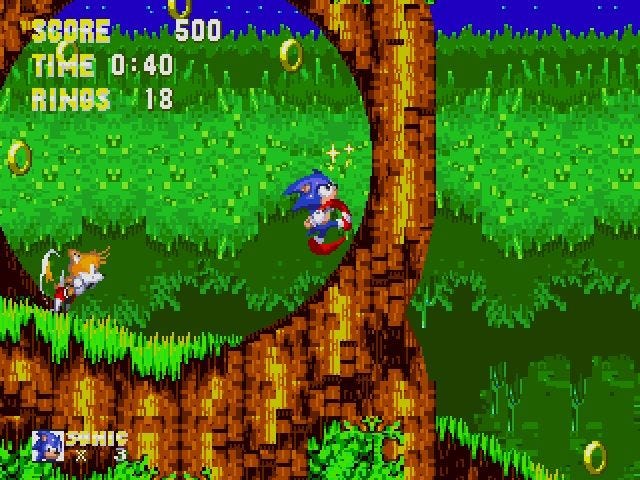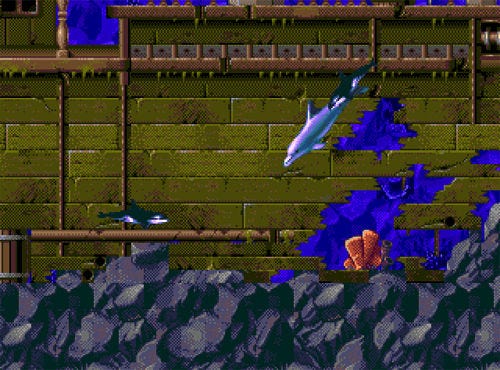1994, The Most Important Year in Gaming, Part 1: Sega
Grab your Sega Saturn and dust off that CRT TV, because we're going back to the '90s.
Written by Tink Edwards
It’s a crisp Fall Saturday in 1994. You groggily open your eyes as the rising sun’s light engulfs your bedroom. Suddenly, you get a burst of energy as you realize what day and time it is. You jump out of bed, not bothering to change out of your jammies, and dart to the kitchen, where a big bowl of your favorite cereal waits for you on the counter. You shout an emphatic but hurried “THANK YOU!” to whoever prepared your delicious breakfast. No time to chat about it. You’ve got cartoons to watch.
You run full-sprint to the living room and stop on a dime in front of your television. The stop is so abrupt you burn your heels on the carpet, and a little milk spills out of your bowl. Somebody else will clean that up, you tell yourself. You reach forward and click on the TV, then plop down cross-legged about two feet from the screen. Your Saturday morning begins.
You’ve already missed the first few minutes of Cro, the animated show about a cave boy and his wooly mammoth friend Phil. The theme song is the best part of the show, and you didn’t get to see it, but that’s OK. You’ll get the next one when the Sonic the Hedgehog show comes on in 25 minutes. Then you’ll click over to FOX for the latest Animaniacs, Eek! the Cat, Batman: The Animated Series, The Tick, and X-Men. Three and a half hours of Saturday morning cartoon bliss await you.
After lunch, it’s video game time. The night before, you rented a strange-looking Super Nintendo game called Breath of Fire. It’s some kind of top-down game (you call it an “upside down game” because you don’t know what top-down means yet) where you are a dragon or something, and you’re joined on your grand adventure by a wolf man and a fairy. It’s all very confusing but so fresh and exciting. You can’t wait to play more. It’s 1994. And you’ve never been happier.
1994: The Most Important Year in Gaming
I know. That headline might seem like an exaggeration. The late 70s - early 80s were as crucial for the medium as any other, but hear me out. Throughout the year, I plan to elaborate on 1994 and the sheer number of noteworthy moments that shook the gaming world, the insane number of landmark titles released, and the emerging hardware that would set the stage in the gaming space for decades to come. It seems as if every month in 1994 held a crazy new industry-upending event.
I’ve been trying to figure out where to start this retrospective series. With so many stories to tell, what’s the best way to begin? Well, how about with the company that took Nintendo to the mat and became the market leader throughout the early '90s? That company had a heck of a year in 1994. Let’s talk about…
Part 1: Sega
With the release of its Genesis / Mega Drive home console in the late 80s, Sega was serious about toppling Nintendo as the premiere gaming company in the market. CEO of Sega of America, Michael Katz, planned to launch a flurry of advertisements and licensing deals to get a leg up on the competition. Just a year into his tenure, Katz was replaced by former Mattel president Tom Kalinske, who pressed on with Katz’s plan to go after Nintendo but also made pivotal decisions – like lowering the price of the console and focusing on releasing sports-related titles – and eventually put Sega over the top. By 1993, they’d become the market leader with the help of Kalinske’s aggressive marketing and, of course, the company’s lovable-yet-edgy mascot, Sonic the Hedgehog.
Moving into 1994, Sega was in a great position to maintain its dominance over Nintendo and create an insurmountable lead in the market. That February, they released Sonic the Hedgehog 3 in North America and Europe. Sonic 3 received nearly universal critical acclaim and was a commercial success, selling more than a million units in the US alone. Later in the year, Sega released its companion game, Sonic and Knuckles, which also sold over a million units. All was seemingly right with the world. But unbeknownst to the public, trouble was brewing at Sega.
The company, while having wildly successful years in the early 90s, was struggling monetarily. True, their Genesis console was performing well, but the competitive price tag wasn’t generating much revenue, and the company had corporate debt, whereas Nintendo was debt-free. Sega of America and Sega of Japan were also at odds. The follow-up console to the Genesis, the Sega Saturn, had been in development since 1992, and SoA and SoJ could not agree on the type of hardware architecture it would use. Kalinske attempted to broker a deal with Silicon Graphics, whose 3D processing technology would later be the backbone of the Nintendo 64 console. Still, SoJ insisted on using a weaker dual-processor system that would ultimately be cheaper. Sega pushed forward with SoJ’s version of the Saturn, and it released in Japan on November 22, 1994.
Hardware Failure
The Saturn had a moderately successful launch in Japan. Its port of the popular Sega arcade title Virtua Fighter helped it sell out completely upon release. With a decently strong list of titles on the horizon, things were looking good for Sega. At least in Japan.
America and Europe wouldn’t get the Saturn for nearly another year. The Genesis was still doing well but showed its age compared to the Super NES's graphical output and the soon-to-be-released Sony Playstation. Sega released its Sega CD add-on to the Genesis, which enabled disc support, in 1992. The peripheral didn’t catch on and ended up only selling a little over 2 million units worldwide – a minuscule number compared to the Genesis lifetime sales, which topped 30 million units.
Sega of America needed a win and something that would keep them in the “bits” conversation – the Sega Genesis was a 16-bit system, while other consoles on the market proudly boasted their 32 and 64-bit capabilities. Regardless of the quality of those machines, Sega saw the higher numbers and panicked. Their console, once seen as the fastest and sleekest little processor on the market (thanks to a disingenuous but genius marketing campaign), would lose momentum once the likes of the 64-bit Atari Jaguar hit the market.
So Sega of America went to work developing another add-on peripheral that would enable the Genesis to output 32-bit content - The Sega 32X. The 32X plugged into the Genesis cartridge slot and had its own top-loading cartridge slot that supported both 32X games and all Genesis cartridges. The add-on was marketed as a graphical beast, able to play 3D games and display twice as many colors as the original console. Meanwhile, in Japan, Sega was busy prepping the Sega Saturn’s launch, creating a splintered set of messages to consumers: buy our new 32-bit add-on, but also wait and buy our new 32-bit console.
Without a cohesive company-wide vision, the 32X launched in America (at the exact same time as the Saturn in Japan) to tepid sales that wouldn’t reach a million units worldwide. Also sporting limited software and support from third parties, the 32X was a major failure for Sega. The Sega Saturn US launch in 1995 would come with its own set of blunders and setbacks. But that’s a story for another time.
1994 wasn’t just the year of the Japanese Saturn and US 32X launches. Sega was also working on a portable version of the Genesis called the Sega Nomad. Their Gameboy competitor, the Sega Game Gear, had been moderately successful, and they looked to increase their foothold in the handheld space. They also released the popular-in-Japan Sega Pico edutainment console in November to a less-than-stellar reception. Check out this insane and inappropriate commercial for the Pico, which, while being aimed at children, still manages to be insultingly edgy.
Overall, it was a lousy year for Sega in the hardware space. The Sony Playstation and Nintendo 64 would quickly outpace the Saturn, the 32X and Nomad wouldn’t gain any traction, and the Pico would top out at around 400,000 units sold in the states. Fortunately for Sega, the software side of things was hitting a crescendo, and there would be a slew of now-classic titles released throughout the year.
I’ll get to those in a bit, but first, I want to talk about Sega’s other innovation from 1994. They made their fair share of mistakes, but regarding this particular creation, they were about as forward-thinking as anyone in the industry. Let’s talk about…
The Sega Channel
Sega was way ahead of the curve in 1994 when they launched the Sega Channel – a subscription-based online service that offered players downloadable games, demos, cheats, and promotions such as contests. The content was made available via satellite connection to a plug-in peripheral that connected to the player’s Genesis console. It was a pricey service at $15 a month, but it was somewhat successful, with a peak subscriber count of more than 250,000 users. While the service ultimately didn’t last, it did predate and accurately predict what content sharing would look like decades later.
Nintendo entered the satellite content market a year later with its Satelliview add-on to the Super Famicom. Nintendo only released the unit in Japan and had a much smaller install base than the Sega Channel at its peak, but, much like its predecessor, it worked as a proof of concept for what would come years later.
The Sega Channel shut down in 1998. Its failings could be chalked up to both poor timing and high costs, as it was released in the twilight years of the Genesis. And though it wasn’t a significant success, Sega moved forward with their online gaming functionality with a hardware device for the Sega Saturn called the Sega Net Link, which used a traditional telephone line to connect multiple Net Link units, allowing players to play games together via a peer to peer connection. They called the Net Link service SegaNet.
Its follow-up console to the Saturn, the Dreamcast, would use SegaNet as its online offering and would prove to be a welcome addition. So, while Sega might’ve struggled mightily in the hardware department, and the Sega Channel and its offshoots didn’t have mass appeal, they still gave the world a brief glimpse into its future.
I’ll See You in Court
In 1993, the video game world was thrust into turmoil when US Senators Joe Lieberman and Herb Kohl took it on in a series of congressional hearings regarding the presence and effects of violent and sexual content in games. The hearings focused on three games: Doom, Night Trap, and Mortal Kombat, two of which were available on Sega hardware at the time. Mortal Kombat was a bloody, ultraviolet fighting game that made its way to the Sega Genesis pretty much in-tact content and feature-wise with its arcade counterpart. Night Trap was a horror-thriller FMV (full motion video) game for the Sega CD add-on, which featured images of “vampires” harassing teenage girls having a slumber party. Both games created commotion among congressional leaders, parents, and people within the video game industry.
Representatives from Sega and Nintendo attended the hearings and gave their testimonies to the committee. Sega was under fire for its home console port of Mortal Kombat. Since the Genesis version of the game outsold the Super NES version by a wide margin, Nintendo jumped at the opportunity to show the board that its games were family-friendly. In contrast, Sega made games for a mature audience. Sega did have its own proprietary rating for the game (MA-13) via its internal ratings board, the Videogame Rating Council, or VRC, which was widely scrutinized in the industry. Thus, the committee tasked the industry with creating its own rating system encompassing all of gaming. The Entertainment Software Rating Board, or ESRB, was introduced and proposed to Congress in 1994 and has been the standard for video game ratings ever since.
Later that year, Nintendo allowed a home port of Mortal Kombat II onto its SNES that contained all of the blood and guts found in the arcade version. Its box sported a ratings label that let the consumer know it was for the 17-and-up crowd. A port of Doom made its way onto the 32X a few months later, with a Super Nintendo version arriving the following year. Like with their innovation in online content distribution, Sega was at the forefront of the video game ratings system, just at the opposite end of that innovation.
The Heavy Hitters
Sega’s 1994 was a wild mix of successes in software and massive hardware failures. We’ve covered the bases of lows, so let’s end on a high note and showcase a few of the games that dropped that year.
Sonic the Hedgehog 3 (and Knuckles)
The blue blur with attitude had his most impressive showing yet with the third installment of the Sonic the Hedgehog series. It introduced Knuckles the Echidna, Angel Island, and one of the first video game soundtracks composed by a mainstream musician – [REDACTED]. The controversy surrounding Sonic 3’s soundtrack is still talked about today. Gameplay-wise, Sonic 3 (and Knuckles) is a masterclass in 2D platforming and one of the best games to release that generation.
Earthworm Jim
Speaking of controversy, Earthworm Jim designer Doug TenNapel’s bigoted beliefs have tainted the game and franchise for many people (including me). The original Earthworm Jim game is a fun action-platformer romp that did well commercially and critically, but I do not want to revisit it. It does belong on this list of notable releases, though.
Ecco: The Tides of Time
The follow-up to Sega’s oceanic adventure starring the dolphin Ecco released to mild acclaim. The sequel improved upon the first game in many ways but wasn’t as successful as the original.
Virtua Fighter
A Saturn launch title in Japan, Virtua Fighter was a worthy port of a popular arcade fighting game. It showed that the Saturn wasn’t a slouch when it came to processing power. It’s a beautiful game even by modern standards, with its vibrant colors and exaggerated polygonal character models.
What’s Next?
Now that we’ve exhausted coverage of Sega (kind of — I could’ve gone into their MGM deal and more of the games from their 1994 catalog), we can move on to the next portion of the retrospective. I haven’t quite nailed down what I want to cover, but trust me when I say there’s plenty to choose from.
Do you have any fond memories of Sega in 1994? Let us know in the comments. We’d love to engage with you and talk about their whirlwind year! Until next time. Later!














